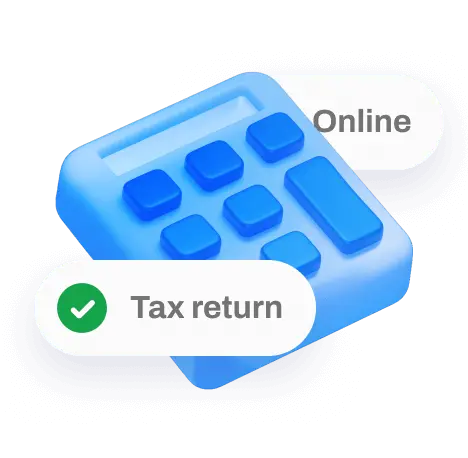How to file Form 1116 and get credit for foreign taxes paid

If you earn income outside the US, chances are you’ve run into the issue of double taxation. The IRS offers ways to avoid that, and one of the most effective tools is the foreign tax credit, claimed using Form 1116.
The process can get complicated, especially if you have income from multiple countries, different types of income, or foreign tax carryovers – this guide breaks it all down.
What is Form 1116?
IRS Form 1116 lets US citizens and resident aliens claim the foreign tax credit, reducing their US tax when they’ve already paid taxes to a foreign country on the same income.
The credit is non-refundable, meaning it can reduce your US tax liability to zero but won’t generate a refund. The form calculates the amount of credit you're eligible for, based on your foreign taxes paid and the proportion of your worldwide income that came from foreign sources.
When is Form 1116 required?
You’ll need Form 1116 to claim a foreign tax credit when:
- You paid or accrued more than $300 in foreign taxes as a single filer, or more than $600 if married filing jointly.
- Your foreign tax situation involves multiple income types or foreign tax carryovers from other years.
You need to comply with FTC limitation rules, which prevent overclaiming the credit.
LIf your foreign taxes are less than the threshold above, and all your foreign income is from passive sources (such as interest or dividends) and from countries with which the US has a tax treaty, you may qualify for the De Minimis Exception. In that case, you can claim the foreign tax credit directly on your Form 1040.
Form 1116 vs Form 2555
Both foreign tax credit (Form 1116) and foreign earned income exclusion (Form 2555) are tools to help avoid double taxation – but they work in different ways:
- Form 1116 gives you a dollar-for-dollar credit for foreign income taxes paid.
- Form 2555 allows you to exclude a portion of your foreign earned income from US taxation entirely.
The foreign earned income exclusion (FEIE) lets you exclude up to $126,500 (2024 limit per taxpayer, adjusted annually) of earned income from your US taxable income, if you meet either the bona fide residence test or the physical presence test.
FEIE is typically more beneficial if you live and work abroad in a country with low or no income tax, or if you earn less than the exclusion limit and want to reduce your taxable income easily. The FEIE applies only to earned income, not to passive income. Also, it doesn’t provide a tax credit for any foreign taxes you’ve already paid – so it’s usually less helpful if you're living in a high-tax country.
Once you elect to use foreign earned income exclusion, you can’t also claim the foreign tax credit on the same income.
Choosing between Form 1116 and Form 2555 depends on where you live, how you earn your income, and how much tax you’ve already paid abroad. At Taxes for Expats, we’ve been doing this for over 20 years – helping thousands of Americans save real money just by getting this choice right. If you’re not sure which way to go – talk to a tax professional.
Who can claim Form 1116: eligibility for the foreign tax credit
You may be eligible to file Form 1116 if you’re a US citizen or resident alien with income from foreign sources that’s also taxed by the US.
As we mentioned above, if your foreign taxes exceed $300 (or $600 if married filing jointly), or your income doesn’t meet the conditions for the De Minimis Exception, you’ll need to file Form 1116 to claim the credit.
Other requirements:
- You paid or accrued foreign income taxes to a foreign country or US possession (special rules apply to income from US possessions.)
- Your income is taxable in the US, and you're not excluding it under the foreign earned income exclusion.
- The tax paid qualifies as an income tax (or a tax in lieu of income tax) under IRS rules.
- You meet all other IRS requirements for the foreign tax credit, including categorizing your income correctly.

How to calculate the foreign tax credit
Categories of income
When completing Form 1116, you’ll need to classify your foreign gross income into IRS-defined categories.
Common categories include:
- passive category income – such as interest, dividends, and royalties
- general category income – wages, salaries, or self-employment income
- section 901(j) income – income from countries under US sanctions
- re-sourced income by treaty – income considered foreign under a tax treaty
- lump-sum distributions – retirement account payouts received as a lump sum
Each income category requires a separate Form 1116. If you earn income from more than one category, you’ll need to fill out multiple forms.
The limitation equation
The FTC is limited to the amount of US tax owed on your foreign income. The IRS uses the following equation to calculate that limit:
foreign tax credit = (foreign source income worldwide income) US tax liability
This formula ensures that your credit only offsets the portion of your US tax that applies to your foreign income – not your entire tax bill.
Carryback and carryover
If your foreign taxes paid exceed what you’re allowed to claim this year, the unused portion doesn’t go to waste.
You can carry back the unused credit to the previous tax year or carry it forward for up to 10 years. This is especially helpful if your foreign tax rate is higher than your US rate or your US tax liability is low in a given year.
Pro tip. The IRS doesn’t track carryover amounts for you. Keep detailed records so you can apply the credits accurately in future years.
Form 1116 foreign tax credit example
Let’s say you earned $10,000 in foreign income and paid $3,000 in foreign taxes. On your US return, your tax liability on that income is $2,500. Using Form 1116, you can claim a foreign tax credit – but only up to the amount of US tax owed on that income. In this case, your FTC would be $2,500.
The unused $500 in foreign taxes could be applied to a prior year’s return or used to reduce your US tax in a future year.
If you elect to claim the foreign tax credit without Form 1116, you cannot carry back or carry forward any unused foreign tax.
High-tax kickout rule
High-tax kickout rule applies when passive income – like interest, dividends, or royalties – is taxed at a high rate by a foreign country. If that rate exceeds 90% of the highest US rate for that income type, the IRS requires you to reclassify it as general category income on Form 1116.
For example:
- interest and royalties: US top rate is 37% threshold is 33.3%
- qualified dividends: US top rate is 20% threshold is 18%
If your foreign passive income is taxed at rates near or above these thresholds, consult a tax professional to determine if the high-tax kickout rule applies to your situation.
Understanding the structure of Form 1116
The form is broken into several parts – here’s a quick overview of what each section covers:
-
Part I – Taxable income or loss from sources outside the United States
This section is where you report your foreign-source income, categorized by type (passive, general, etc.). You’ll also report deductions that relate specifically to your foreign income. -
Part II – Foreign taxes paid or accrued
Here, you list the foreign taxes paid or accrued during the year. You must report these amounts in US dollars and provide details about the foreign country, type of tax, and whether the tax was paid or accrued. -
Part III – Figuring the credit
This is where you apply the FTC limitation formula to determine how much of your foreign tax can actually be claimed as a credit. -
Part IV – Summary of credits from all Forms 1116
If you’re filing more than one Form 1116, this section adds them all up. It provides a total foreign tax credit amount to be carried over to your Form 1040.
You may also need to attach supporting statements or worksheets, depending on your situation – for example, if you’re claiming a carryover or have taxes re-sourced under a treaty.
Form 1116 preview
Step-by-step guide to filing Form 1116
Filing Form 1116 can be intricate, so it’s essential to approach it methodically. Here’s a step-by-step guide to help you accurately report your foreign income.
Step 1: Gather your documents
Start by collecting everything you’ll need to report your foreign income and taxes:
- Foreign tax returns
- Wage or earnings statements
- Bank and brokerage statements
- Dividend or interest distribution notices
- Receipts or proof of tax payments
You’ll also need exchange rate info – see yearly average exchange rates for converting foreign currencies into US dollars.
Step 2: Determine eligibility
Confirm that you qualify to claim the foreign tax credit. If you’re under the De Minimis Exception threshold and meet the criteria, you might not need to file Form 1116 – but most taxpayers with significant foreign income will.
Step 3: Choose between FTC and FEIE
You typically need to choose between claiming the foreign tax credit (Form 1116) and excluding foreign earned income (Form 2555.) Remember, you can’t do both for the same income. This decision affects your tax outcome and your filing status in future years.
FTC or FEIE? Don’t guess – get it right
Book free consultationStep 4: Complete Form 1116 (Parts I-IV)
Fill out Form 1116 and:
- report foreign income by category
- list foreign taxes paid or accrued
- apply the FTC limitation formula
- summarize your total credits
If applicable, include carryover amounts from past years or taxes re-sourced by treaty. Be accurate and consistent with exchange rates and income categorization.
Step 5: Attach Form 1116 to your tax return and submit
Once the form is complete attach it to your Form 1040 or Form 1040-SR. Include all supporting documentation and double-check for missing information or math errors.
You can e-file your return or mail it in, depending on your situation.
Step 6: Track carryovers and keep records
If you have unused foreign taxes, record them accurately. Keep copies of Form 1116, your tax return, and all related documents for at least three years. These records may be needed for IRS review or to apply unused credits in the future.
Even small errors on the form can trigger IRS scrutiny. If you have multiple sources of income or are unsure about the process, our tax professionals can help – drop us a line.
Common mistakes to avoid
- Not reporting all foreign income: Underreporting can result in penalties. Ensure you report all foreign income, regardless of whether tax was paid.
- Double benefits: Be cautious not to claim both the foreign tax credit and foreign earned income exclusion on the same income.
- Incorrect exchange rates: Use the correct exchange rates as per IRS guidelines.
- Failing to categorize income properly: Properly categorize your foreign income in Part I to avoid miscalculations.
Filing Form 1116 feels overwhelming? We’ve got your back
When your income spans countries, currencies, and categories – Form 1116 can get complicated fast. But you don’t have to figure it out alone.
At Taxes for Expats, you’ll work one-on-one with a tax expert – not software, not templates. Just someone who knows the ins and outs of expat taxes and takes the time to understand your situation.
We’ll help you file your tax form correctly or recommend a better option if it means lowering your tax bill. Either way, we’ll make sure you’re paying what you owe, and not a dollar more.
Taxes are complicated. Get peace of mind with TFX
Get started


